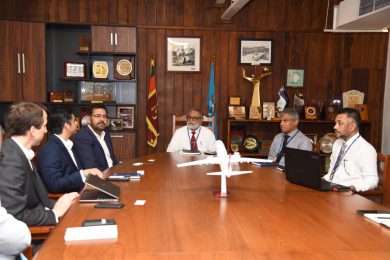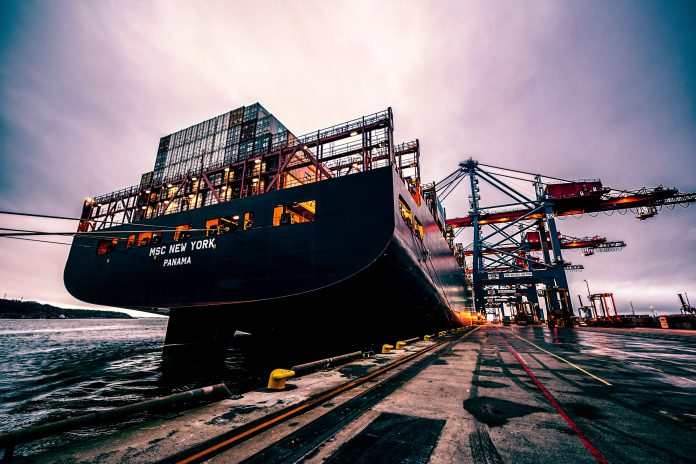Players in the shipping market are attempting to innovate, collaborate with other stakeholders, participate in technology platforms trying to find the proper formula in order to take the full advantage from the digitalisation and technology.
by Antonis Karamalegkos
Shipping’s main challenge is to use the massive introduction of the digital tools, caused by the Covid-19 pandemic, to accelerate the development of safety solutions.
Digitalisation has probably become one of the most frequently used words in the container shipping lexicon. It includes all the new technologies that aim to increase the efficiency of the shipping processes.
But it remains unclear whether digitalisation and these new technologies have contributed to the safety and the security of the container shipping industry.
According to Richard Brough, the head of the International Cargo Handling Coordination Association (ICHCA), anything that helps with the improvement of systems in machinery and processes increases safety. Container sensors and drive control modifications are “two of the countless examples” where technology assists and augments the human interaction with machines and processes.
“Computer technology and Artificial Intelligence (AI) are prevalent in many terminals through Terminal Operating Systems (TOS) and related systems which increase the efficiency and the safety of terminals,” Brough told Container News.
For example, remote technology that places the driver from the cab into the control room, which is expected to be developed even further, avoids the risk of the driver being in a vehicle.
The use of technology in assisting in the reduction of human error and to the improvement of checking throughout the supply chain enhances security, according to Brough, who went on to say that Hapag-Lloyd’s Cargo Patrol system, cargo detection software capable of finding undeclared dangerous cargo, is a classic example of AI use for detection of fraud and mis-declared cargoes.
Nils Haupt, senior director corporate communications of Hapag-Lloyd, believes that new technical opportunities driven by digitalisation are allowing a much easier and faster collection of operational and conditional data in a very timely manner. “This allows us to reduce the workload of crewmembers as well as realising and reacting early to critical conditions increasing the safety of the vessel and occupational safety,” he said.
One of the main challenges which the shipping industry has faced over the years is fires, either in the engine room or in cargo containers. The industry is struggling to contain and fight fires on board the vessels, or indeed, in ports or terminals, while other accidents such as those caused by ship collisions, engine failures, cargo explosions, poorly packed containers, over-weight boxes, or bad weather, are also a grave concern.
Uwe-Peter Schieder, a Master Mariner of German Insurance Association Marine and Loss Prevention, has noted a list with the cargo fires since 2016, which the public was aware of:
| 2016 Sep – CCNI Arauco | 2017 Apr – MSC Daniela | 2018 Mar – Maersk Kensington | 2019 Jan – APL Vancouver | 2019 May – KMTC Hong Kong |
| 2016 Sep – Wan Hai 307 | 2017 May – Maersk Karachi | 2018 Jun – SSL Kolkata | 2019 Feb – E.R. Kobe | 2019 Aug – APL Le Havre |
| 2017 Feb – APL Austria | 2018 Mar – Maersk Honam | 2019 Jan – Yantian Express | 2019 Mar – Grande America | 2020 Jan – COSCO Pacific |
If evidence was needed that there was significantly more work needed to reduce fires and other accidents, then 2019, a record year in terms of major accidents, particularly fire incidents in the container shipping sector, provided that proof.
Technology is a recent addition to shipping’s armoury in the battle against such accidents within the containerised supply chain, but we have not yet seen significant improvements.
The International Union of Marine Insurance (IUMI) has emphasised that in its last year’s statistics report, saying that “2019 was characterised by a renewed impact of major losses and especially a high number of fires on container vessels.”
The following statistics from the Nordic Association of Marine Insurers (Cefor) show clearly that fire incidents skyrocketed in the previous year, while they also indicate that the larger ships are most affected.



IUMI’s position paper reported on this issue and recommended that firefighting systems should be arranged to segregate the ship into fire compartments where the fire can be isolated, preventing the spread to other compartments and limiting the fuel for the fire.
“Onboard systems could then cool the containers and allow them to burn out in a controlled manner. Better prevention measures must also address the concerning rise in cargo misdeclaration,” the union stated.
The risk of large event losses, both natural catastrophe and man-made, is substantially increasing both on single sites and single assets, according to IUMI’s report.
Ashore, there have been cargo storage losses in 2017 and 2018 from natural incidents (including hurricanes, earthquakes and flooding) as well as a number of significant fire losses over the last year.

The key for Mike Yarwood, managing director loss prevention at TT Club, is the transparency in the booking stage, where the hazardous and dangerous cargo must be detected. This is the most efficient way for the proper handling and placement (if the ship accepts hazardous and dangerous material) of these special containers.
There are several accidents, which were caused by mistakes in the loading process due to the lack of knowledge about what is inside the container.
An indicative example was noted at the beginning of the year, when lithium ion batteries stored in a container on board the Chinese container ship Cosco Pacific exploded and led to a dangerous cargo fire.
The 10,000TEU vessel was underway in Arabian sea off southwest Indian coast, sailing from Malaysia to India on 4 January 2020, when the fire eruption forced it to divert to the Sri Lankan port of Colombo.
Two containers were destroyed, but no other damage to other containers or to the ship were reported. “It was a fire that started at sea and it was brought under control using the cargo hold’s CO2 system, but two containers were damaged, and they contained batteries,” Port of Colombo MD Captain Athula Hewavitharana commented at the time.
As a container ship fire safety expert had unveiled on Container News, Cosco Pacific was lucky to have escaped a major incident, because the lithium batteries on the vessel were not declared and were therefore incorrectly stowed.
Reports suggest that the cargo was listed as spare parts and accessories and was a consignment of three boxes loaded by the Taiwan-based carrier Wan Hai Lines under a vessel sharing agreement with Cosco.
“Both alkaline and acid batteries are categorised as class 8 corrosives in the International Maritime Dangerous Goods (IMDG) Codes and so the crew would have stowed the cargo correctly in the hold, if the ship had the authorisation to carry Class 8 goods in this way,” explained the expert.
Another representative case is the fire on board the 2001-built container vessel MSC Flaminia in July 2012. The 6,750TEU boxship transported 2,876 containers, 149 of which were carrying dangerous goods.
On 14 July, a fire in hold 4 caused an explosion aboard the ship, while it was underway from the Port of Charleston, United States, to the port of Antwerp, Belgium. In this case, there was a tragic toll of three lives lost (two confirmed dead and one still missing), while the rest of the crew abandoned the vessel in the middle of the Atlantic Ocean.
Maritime authorities have declared the primary cause of the MSC Flaminia accident to be on account of a discrepancy in the declared cargo and the actual cargo contained in the ship.
The two detonations aboard the MSC container vessel led to a fire that firefighters could not contain for weeks and is regarded as a dangerous lapse in documentation and verification of cargo systems.
The Court determined that the explosion was caused by the auto-polymerisation of a hazardous chemical called Di-Vinyl Benzene (DVB), with factors such as the temperature and the length of time the cargo was exposed to direct sunlight being the key factors in leading to the DVB undergoing the reaction, reported Burgoynes, an international partnership specialising in the investigation of fires, explosions and other major incidents, which took part in the investigation of MSC Flaminia case.
In a landmark ruling the liability trial in August 2018 found that the manufacturers and shippers of the DVB (joint defendants) were 100% liable and that there was no liability attached to the other parties involved, including the owners and their ship management company. The Defendants have lodged an appeal.
The Federal Bureau for Maritime Casualty Investigation (Bundesstelle für Seeunfalluntersuchung – BSU), a German agency for investigating maritime accidents and incidents, recommended in its accident report that the Federal Ministry of Transport and Digital Infrastructure must campaign at the International Maritime Organization (IMO) to develop the regulatory system on dangerous goods further, and to introduce better transport restrictions, while the shipper should be required to declare the properties of their cargoes.

According to the BSU report, which was published in February 2014, also recommended that the ministry and IMO add to the SOLAS-Convention, in order to improve the technical requirements for firefighting equipment on container vessels.
However, Haupt and Brough seem to agree that there has not been any noteworthy progress in the technology for fighting onboard fires. The ICHCA head emphasised the pressures on the IMO by many governments and non-governmental organisations (NGO) for onboard ship changes, in terms of provision and design and in terminals with greater detection and enforcement of regulations.
“ICHCA is going to mount a campaign shortly on greater awareness in ports and terminals on emergency response, training and drills and better co-operation with the fire and rescue services, which in some terminals is woefully inadequate,” he revealed.
Detection and declaration of the cargo in a container is the key to making the industry safer.
One possible technical fix, which is much talked about, but has yet to be developed into an industry standard is blockchain technology, which can significantly enhance the monitoring systems at ports and terminals and increase the efficiency of the detection processes.
The combination of data streams from multiple sources supports the maritime industry to make better-informed decisions more quickly, creating more efficient and responsive organisations, according to DNV GL, a leading classification society for the maritime industry.
The company believes, “New cloud-based technologies such as big data platforms and digital twin technologies are starting to have a dramatic effect on how the industry manages information and how vessels and their components are designed, built, and tested.”

Traceability is at the core of the applications associated with the technology, so introducing blockchain to container shipping is a natural fit, according to Deanna MacDonald, co-founder of BunkerTrace and CEO of BLOC (Blockchain Labs for Open Collaboration).
Brough thinks it is difficult to see how blockchain technology will make a significant difference to safety, except where it can ensure regulatory compliance.
MacDonald, however, understands a blockchain solution through a system of known trusted parties makes sure that compliance takes place. “Blockchain enables a shared, unalterable store of data which allows trust to be established between parties without intermediation – and as such, it is applicable to various use cases in the container shipping industry, such as crew documentation, managing the marine fuels supply chain, and the declaration of dangerous goods,” she explains.
BunkerTrace, a joint venture that combines solutions and expertise from technology innovators BLOC and Forecast Technology Ltd., is a tool that offers all involved access to real-time information in a digital format and helps operations run smoothly and efficiently.
MacDonald explained to Container News that there was a limited ability for the accurate representation of what happens in the physical realm when working in the digital realm. So, they integrated blockchain with synthetic DNA in one solution to enable instant physical field inspections and results, recording transactions and providing digital and physical evidence of compliance.
“This added a layer of traceability where the physical and digital streams of information reinforce one another and allows for a much greater degree of assurance for multiple parties,” she highlighted.

BunkerTrace is operational in the fuels sector, and the experience gained from that methodology can inform the development of cargo integrity systems, “By better linking to a highly fragmented chain of custody to provide better evidence of compliance, we are using blockchain and synthetic DNA tags to tackle critical safety issues,” claimed MacDonald.
According to the Cargo Incident Notification System (CINS), nearly 25% of all serious incidents onboard container ships were attributable to mis-declared cargo – many of which are fires. In light of this, BLOC convened a consortium last year in co-operation with Lloyds Register Foundation (LRF) to explore the use of digital tools for traceability of dangerous cargo, and immutable attestations and digital audit trails for due diligence with a view to better tracking dangerous goods; ultimately, reducing incidents.
Continuously tracking and monitoring the contents of seafaring containers is a supremely complex task that demands co-operation amongst stakeholders and a high level of data interoperability and information sharing, according to BLOC chief executive. The need for collaboration is also highlighted by Mike Yarwood, who believes that it is the most important element for the acceleration of the shipping digitalisation.
“Shipping containers often carry little to no indication of their specific contents. At best, a product code is scanned, traced, and managed by siloed data systems, which rarely interoperate with data systems managed by other stakeholders along the connected value chain. This is compounded by weak enforcement, documentation complexity, lack of transparency of the containers’ content,” added MacDonald.

Emma Mark, head of operations at Intelligent Cargo Systems, a London-based maritime technology company which recently signed a partnership agreement with Hapag-Lloyd, considers that the solution is in mitigating the human error. “At present crew use paper manifests to check the identification and placard numbers for all IMDG containers that are loaded onboard,” she said.
“By digitalising that process and sharing the correct information via our CargoMate Mobile device, the margin for human error can potentially be reduced whilst improving the onboard processes for crew checking,” she argued.
The Covid-19 crisis showed emphatically the importance for companies to be technology-savvy and to have the ability to use digital tools to face and adapt to unexpected and unprecedented situations. These companies made the real difference in this challenging period and gained an essential advantage to its competitors.
Players in the shipping market are attempting to innovate, collaborate with other stakeholders, participate in technology platforms trying to find the proper formula in order to take the full advantage from the digitalisation and technology.

Although several elements of the industry are resisting this transformation phase, it seems that the technological revolution will inevitably lead to a radical change within the maritime sector.
That will alter the rules of the game. The first-mover advantage is an important and widely popular term in marketing, which is used to describe the advantage gained by the initial, significant company or person to upgrade to new technology or systems, taking some risk that others will not follow their lead.
The first-mover advantage could play a crucial role in the coming years. Digitalisation of shipping is a fact and the pace of change is gathering speed. But the player with the first-mover advantage will be defined now.
Courtesy: Container-News























